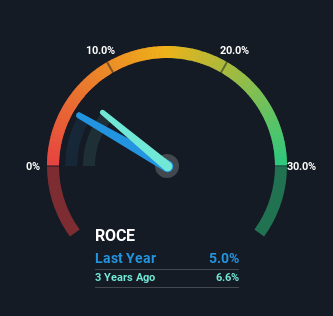Investors Will Want BBD Initiative's (TSE:5259) Growth In ROCE To Persist
What trends should we look for it we want to identify stocks that can multiply in value over the long term? One common approach is to try and find a company with returns on capital employed (ROCE) that are increasing, in conjunction with a growing amount of capital employed. Put simply, these types of businesses are compounding machines, meaning they are continually reinvesting their earnings at ever-higher rates of return. So when we looked at BBD Initiative (TSE:5259) and its trend of ROCE, we really liked what we saw.
Understanding Return On Capital Employed (ROCE)
If you haven't worked with ROCE before, it measures the 'return' (pre-tax profit) a company generates from capital employed in its business. Analysts use this formula to calculate it for BBD Initiative:
Return on Capital Employed = Earnings Before Interest and Tax (EBIT) ÷ (Total Assets - Current Liabilities)
0.05 = JP¥107m ÷ (JP¥3.7b - JP¥1.6b) (Based on the trailing twelve months to March 2023).
Therefore, BBD Initiative has an ROCE of 5.0%. Ultimately, that's a low return and it under-performs the Software industry average of 15%.
Check out our latest analysis for BBD Initiative

Historical performance is a great place to start when researching a stock so above you can see the gauge for BBD Initiative's ROCE against it's prior returns. If you want to delve into the historical earnings , check out these free graphs detailing revenue and cash flow performance of BBD Initiative.
The Trend Of ROCE
While in absolute terms it isn't a high ROCE, it's promising to see that it has been moving in the right direction. Over the last four years, returns on capital employed have risen substantially to 5.0%. The amount of capital employed has increased too, by 28%. This can indicate that there's plenty of opportunities to invest capital internally and at ever higher rates, a combination that's common among multi-baggers.
For the record though, there was a noticeable increase in the company's current liabilities over the period, so we would attribute some of the ROCE growth to that. Essentially the business now has suppliers or short-term creditors funding about 42% of its operations, which isn't ideal. And with current liabilities at those levels, that's pretty high.
In Conclusion...
To sum it up, BBD Initiative has proven it can reinvest in the business and generate higher returns on that capital employed, which is terrific. Astute investors may have an opportunity here because the stock has declined 34% in the last five years. So researching this company further and determining whether or not these trends will continue seems justified.
On a final note, we've found 5 warning signs for BBD Initiative that we think you should be aware of.
While BBD Initiative may not currently earn the highest returns, we've compiled a list of companies that currently earn more than 25% return on equity. Check out this free list here.
Valuation is complex, but we're here to simplify it.
Discover if BBD Initiative might be undervalued or overvalued with our detailed analysis, featuring fair value estimates, potential risks, dividends, insider trades, and its financial condition.
Access Free AnalysisHave feedback on this article? Concerned about the content? Get in touch with us directly. Alternatively, email editorial-team (at) simplywallst.com.
This article by Simply Wall St is general in nature. We provide commentary based on historical data and analyst forecasts only using an unbiased methodology and our articles are not intended to be financial advice. It does not constitute a recommendation to buy or sell any stock, and does not take account of your objectives, or your financial situation. We aim to bring you long-term focused analysis driven by fundamental data. Note that our analysis may not factor in the latest price-sensitive company announcements or qualitative material. Simply Wall St has no position in any stocks mentioned.
About TSE:5259
Slight risk with weak fundamentals.
Market Insights
Community Narratives




